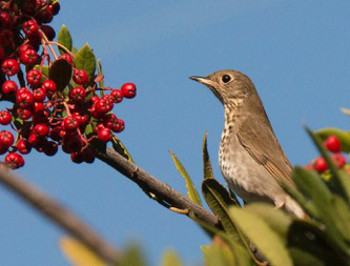The soft “chup” from deep in the shrubbery is easy to translate. It says, a hermit thrush is here wondering who you are and what you are doing so close to where I live. And you can answer, should you wish to using that same soft sound. The final “p’ is not the plosive p of English, but the more restrained, almost silent p of Spanish, and the opening “ch” is not the usual English ch made with the forward part of the tongue against the palate, but with the middle tongue instead. It’s a sound as soft and pleasing as the soft browns of this plump little bird’s plumage, should you chance to see it.

But seeing a hermit thrush is not so easy, even though they are abundant in our more shrubby hillsides, canyons and yards during the winter months. These birds are secretive and can be hard to see even when you are looking directly at one. Their muted colors blend with the dense brush in which they are usually found so that until the bird moves—and they can sit still for long periods when inclined to do so—they look like just another branch of the tree they are sitting in.
There are times and places where you can see these birds, though. Find a Christmasberry tree (toyon) in January or February and sit ye doon for a wee while. The ripe fruits hang in luscious (for birds) scarlet clusters just ready for plucking and eating. And the birds love them!
Should you venture into hermit thrush habitat on an early spring morning you have a chance to hear their song, one of the most beautiful and haunting sounds in all nature. From some hidden place in the brush there will come a fluted whistle followed be a looping series of rising clear notes welcoming the rising sun as pure as the dawn air itself. And pure that song is, too, such that the Greek “catharos,” meaning pure, has been taken for the Genus name Catharus for the hermit thrush. Their gorgeous songs make waking up and getting out on a cold April morning into one of our deep canyons more than worthwhile, it is an experience that will last with you for a lifetime.


